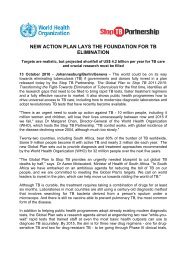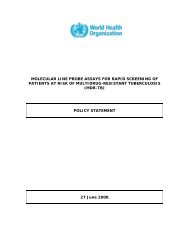Concept note on national stop TB partnership [.pdf]
Concept note on national stop TB partnership [.pdf]
Concept note on national stop TB partnership [.pdf]
You also want an ePaper? Increase the reach of your titles
YUMPU automatically turns print PDFs into web optimized ePapers that Google loves.
Draft_April 2010<br />
Partnering initiatives at country level: proposed partnering process to<br />
build a nati<strong>on</strong>al <strong>stop</strong> tuberculosis (<strong>TB</strong>) <strong>partnership</strong><br />
C<strong>on</strong>tents<br />
1. Background................................................................................................................................... 1<br />
2. What is a nati<strong>on</strong>al <strong>stop</strong> <strong>TB</strong> <strong>partnership</strong>? .................................................................................. 1<br />
3. Why to establish a nati<strong>on</strong>al <strong>stop</strong> <strong>TB</strong> <strong>partnership</strong>? .................................................................. 2<br />
4. Who can lead the process to establish a nati<strong>on</strong>al <strong>stop</strong> <strong>TB</strong> <strong>partnership</strong>? ............................ 3<br />
5. How does the partnering process work? .................................................................................. 3<br />
6. What should be c<strong>on</strong>sidered when costing the partnering process? .................................... 5<br />
1. Background<br />
Tuberculosis (<strong>TB</strong>) kills nearly two milli<strong>on</strong> people every year - 5000 every day - mainly in the<br />
poorest communities in the developing world. It afflicts milli<strong>on</strong>s more. About <strong>on</strong>e third of the<br />
world's populati<strong>on</strong> is infected with <strong>TB</strong> - that is, they have a latent <strong>TB</strong> infecti<strong>on</strong> that may later<br />
cause disease to develop. Nearly nine milli<strong>on</strong> new cases are estimated to develop every<br />
year.<br />
The fifth comp<strong>on</strong>ent of the Stop <strong>TB</strong> Strategy aims at empowering people with <strong>TB</strong>, and<br />
communities through <strong>partnership</strong>. Partnership is an innovative way to engage in <strong>TB</strong> c<strong>on</strong>trol,<br />
by taking into account the competencies and comparative advantages of actors that come<br />
from different sectors of society and play a role at the level where they can perform better<br />
and more effectively.<br />
The nature of these <strong>partnership</strong>s is voluntary and necessarily country-specific, expressing<br />
typical cultural and organizati<strong>on</strong>al diversity. Depending <strong>on</strong> the local situati<strong>on</strong>, countries might<br />
decide to initiate a partnering initiative to c<strong>on</strong>tribute to the fight to <strong>stop</strong> tuberculosis<br />
(hereinafter referred to as nati<strong>on</strong>al <strong>stop</strong> <strong>TB</strong> <strong>partnership</strong>). Local partners will be deciding<br />
whether such an initiative would have any added value for <strong>TB</strong> preventi<strong>on</strong>, care and c<strong>on</strong>trol or<br />
it would be more appropriate to c<strong>on</strong>tinue with a simple coordinati<strong>on</strong> of activities, as it might<br />
be already in place in some countries. This approach is based <strong>on</strong> the fact that nati<strong>on</strong>al<br />
challenges require a nati<strong>on</strong>al resp<strong>on</strong>se.<br />
Once this initiative is taken, it is important the focal point be in touch with the Secretariat of<br />
the Global Stop <strong>TB</strong> Partnership, as its staff could provide technical assistance <strong>on</strong> the<br />
proposed partnering process based <strong>on</strong> good practices developed in other countries.<br />
Informati<strong>on</strong> can be found <strong>on</strong> the website <strong>on</strong> nati<strong>on</strong>al <strong>stop</strong> <strong>TB</strong> <strong>partnership</strong>s available at:<br />
http://www.<strong>stop</strong>tb.org/countries/<strong>partnership</strong>s/.<br />
2. What is a nati<strong>on</strong>al <strong>stop</strong> <strong>TB</strong> <strong>partnership</strong>?<br />
- A nati<strong>on</strong>al <strong>stop</strong> <strong>TB</strong> <strong>partnership</strong> is a voluntary alliance between organizati<strong>on</strong>s drawn from<br />
different sectors of society (government, civil society and private/corporate sector) who<br />
commit to work collaboratively towards <strong>TB</strong> preventi<strong>on</strong>, care and c<strong>on</strong>trol, in which all<br />
partners c<strong>on</strong>tribute from their core competencies, share risks and resp<strong>on</strong>sibilities and<br />
benefit by achieving their own, each others and the overall goal.
- It aims at strengthening the preventi<strong>on</strong>, care and c<strong>on</strong>trol of tuberculosis in a given country<br />
towards the targets of the Global Plan to Stop <strong>TB</strong> 1 , in close collaborati<strong>on</strong> with the nati<strong>on</strong>al<br />
<strong>TB</strong> c<strong>on</strong>trol programme (NTP) and with the support, if needed, of the Global Stop <strong>TB</strong><br />
Partnership Secretariat. Civil society/private/corporate sector actors will be equal and<br />
independent partners, and work within the framework of the nati<strong>on</strong>al <strong>TB</strong> plan.<br />
- A nati<strong>on</strong>al <strong>stop</strong> <strong>TB</strong> <strong>partnership</strong> can c<strong>on</strong>tribute to the implementati<strong>on</strong> of the nati<strong>on</strong>al plan<br />
to c<strong>on</strong>trol <strong>TB</strong> by harnessing the c<strong>on</strong>tributi<strong>on</strong> of all relevant stakeholders. For this reas<strong>on</strong>,<br />
its main focus is decided by its partners <strong>on</strong> a case by case basis and it can vary<br />
depending <strong>on</strong> the country c<strong>on</strong>text. Current examples range from the Canadian<br />
<strong>partnership</strong> focusing <strong>on</strong> advocacy and resource mobilizati<strong>on</strong> to Stop <strong>TB</strong> Swaziland<br />
focusing <strong>on</strong> coordinati<strong>on</strong> of service delivery<br />
3. Why to establish a nati<strong>on</strong>al <strong>stop</strong> <strong>TB</strong> <strong>partnership</strong> 2 ?<br />
The operati<strong>on</strong>al challenges of <strong>TB</strong> c<strong>on</strong>trol and the social aspects of the disease demand a<br />
joint effort of instituti<strong>on</strong>s, civil society and private/corporate sectors. While governments are<br />
resp<strong>on</strong>sible for ensuring services reach the people in need, different actors (civil society and<br />
private/corporate sector) are often involved in <strong>TB</strong> preventi<strong>on</strong>, care and c<strong>on</strong>trol. In this<br />
situati<strong>on</strong>, governments could recognize and support as part of the public system other actors<br />
that instituti<strong>on</strong>ally do not bel<strong>on</strong>g to the state ("public functi<strong>on</strong> of private initiative")..<br />
The benefits of establishing a nati<strong>on</strong>al <strong>stop</strong> <strong>TB</strong> <strong>partnership</strong> may vary and occur at different<br />
stages or simultaneously. They include:<br />
1. Coordinati<strong>on</strong> and a comm<strong>on</strong> strategy. Partners agree to work towards a visi<strong>on</strong> and the<br />
achievement of a comm<strong>on</strong> goal. The <strong>partnership</strong> offers a forum where partners exchange<br />
informati<strong>on</strong>, discuss and negotiate <strong>on</strong>e shared goal and a corresp<strong>on</strong>dent shared strategy.<br />
In this way, <strong>partnership</strong>s facilitate the coordinati<strong>on</strong> and synergy of work usually d<strong>on</strong>e in<br />
parallel by different organizati<strong>on</strong>s and, therefore, avoid duplicati<strong>on</strong> of effort and waste of<br />
time and resources.<br />
2. Multi-sectoral participati<strong>on</strong>. Partners from different sectors of society (public,<br />
private/corporate, civil society) and with different backgrounds (medical doctors, social<br />
scientists, community workers, business managers, etc.) are involved. Each partner<br />
could c<strong>on</strong>tribute to the <strong>partnership</strong> and the achievement of the comm<strong>on</strong> goal according to<br />
its specific role and competence. In this way, <strong>partnership</strong>s introduce a new and<br />
innovative way of working across different sectors of the society, including a need to<br />
discuss and compare different approaches and find a c<strong>on</strong>sensus <strong>on</strong> the most appropriate<br />
<strong>on</strong>e. Within a <strong>partnership</strong>, partners would reciprocally respect their identity, and<br />
competiti<strong>on</strong> would give way to efforts to maximize synergies and complementarities.<br />
3. Increased resources. Partners bring to the <strong>partnership</strong> the full range of technical, human,<br />
knowledge, physical and network resources found within all sectors. In this way,<br />
<strong>partnership</strong>s go bey<strong>on</strong>d the c<strong>on</strong>cepti<strong>on</strong> of financial resources as sole type of resources.<br />
1 Stop <strong>TB</strong> Partnership and World Health Organizati<strong>on</strong>. Global Plan to Stop <strong>TB</strong> 2006-2015. Geneva,<br />
World Health Organizati<strong>on</strong>, 2006 (WHO/HTM/S<strong>TB</strong>/2006.35) available at<br />
http://www.<strong>stop</strong>tb.org/globalplan/.<br />
2 For more informati<strong>on</strong> <strong>on</strong> the rati<strong>on</strong>ale and benefits of nati<strong>on</strong>al <strong>partnership</strong>s: The power of<br />
<strong>partnership</strong>s. Geneva, World Health Organizati<strong>on</strong>, 2003 (WHO/HTM/S<strong>TB</strong>/2003.24) available at<br />
http://www.<strong>stop</strong>tb.org/resource_center/assets/documents/WHO-HTM-S<strong>TB</strong>-2003.24-PocketG-<br />
2colorsfin.<strong>pdf</strong>.<br />
2
4. Pro-active leadership. Within a <strong>partnership</strong>, the leadership functi<strong>on</strong> can be attributed to<br />
different partners depending <strong>on</strong> the skills and competencies required by the acti<strong>on</strong>s<br />
undertaken. The leadership is divided am<strong>on</strong>g the partners, and representati<strong>on</strong> of all<br />
c<strong>on</strong>stituencies is ultimately maintained.<br />
5. Social capital. There is a value in <strong>partnership</strong> that goes bey<strong>on</strong>d the value of its<br />
operati<strong>on</strong>al return. This value is based <strong>on</strong> the dialogue and collaborati<strong>on</strong> established<br />
during the partnering process and documented by joint efforts/activities that strengthen<br />
social solidarity and c<strong>on</strong>tribute to the comm<strong>on</strong> good of the society 3 .<br />
6. Social change. By a way of involving different stakeholders of <strong>TB</strong> c<strong>on</strong>trol, <strong>partnership</strong> is<br />
an agent of social change. Involving partners from the civil society could, for example,<br />
help the empowerment of people affected by <strong>TB</strong> and their communities as well as<br />
communicati<strong>on</strong>s and service delivery in remote areas and disadvantaged groups. In this<br />
way, <strong>partnership</strong>s promote a holistic and a participatory approach to health development.<br />
4. Who can lead the process to establish a nati<strong>on</strong>al <strong>stop</strong> <strong>TB</strong> <strong>partnership</strong>?<br />
The initial partners of a nati<strong>on</strong>al <strong>stop</strong> <strong>TB</strong> <strong>partnership</strong> are organizati<strong>on</strong>s, working at country<br />
level, that promote the partnering process. The initial partners act as broker/facilitator of the<br />
partnering process or hire an external broker/facilitator for this task.<br />
Initial partners may involve:<br />
- Instituti<strong>on</strong>s: Nati<strong>on</strong>al <strong>TB</strong> Programme and WHO, including the Stop <strong>TB</strong> Partnership<br />
Secretariat.<br />
- Other actors involved/interested in the fight against <strong>TB</strong>: n<strong>on</strong>governmental organizati<strong>on</strong>s,<br />
private/corporate sector, community based organizati<strong>on</strong>s, faith based organizati<strong>on</strong>s.<br />
The first stakeholders to join the initial partners in their effort form the core group of<br />
interested partners. This group meets regularly to spearhead the partnering process and<br />
produce the basic documents to be circulated am<strong>on</strong>g the wider group of partners.<br />
5. How does the partnering process work?<br />
The partnering process is a dynamic process based <strong>on</strong> three c<strong>on</strong>tinuously evolving<br />
comp<strong>on</strong>ents: <strong>partnership</strong> explorati<strong>on</strong>, building and maintenance.<br />
Before starting with the partnering process, the initial partners should make sure that the<br />
following prerequisites are clearly established:<br />
• Initial partners are committed to work in close coordinati<strong>on</strong> with the nati<strong>on</strong>al <strong>TB</strong><br />
programme and the nati<strong>on</strong>al <strong>TB</strong> programme is willing to be involved in a partnering<br />
process.<br />
• The objectives of the nati<strong>on</strong>al <strong>TB</strong> plan provide the basis to establish collaborati<strong>on</strong> with<br />
various partners.<br />
• Pre-existing forms of collaborati<strong>on</strong>/coordinati<strong>on</strong> are identified, and if existing, c<strong>on</strong>tacted<br />
and involved (Interagency Coordinati<strong>on</strong> Committee - ICC, Country Coordinating<br />
Mechanism - CCM, Nati<strong>on</strong>al <strong>TB</strong>TEAM 4 , Public-Private Mix Group 5 ). In some countries,<br />
3 See <str<strong>on</strong>g>note</str<strong>on</strong>g> 3.<br />
4 For more informati<strong>on</strong> <strong>on</strong> the Nati<strong>on</strong>al <strong>TB</strong>TEAM, you can c<strong>on</strong>sult:<br />
http://www.<strong>stop</strong>tb.org/countries/tbteam/assets/documents/Nati<strong>on</strong>al_<strong>TB</strong>TEAM_TOR_5nov.<strong>pdf</strong><br />
5 For more informati<strong>on</strong> Public-Private Mix Group, you can c<strong>on</strong>sult:<br />
http://whqlibdoc.who.int/hq/2006/WHO_HTM_<strong>TB</strong>_2006.360_eng.<strong>pdf</strong><br />
3
existing forms of collaborati<strong>on</strong> might already functi<strong>on</strong> as a nati<strong>on</strong>al <strong>stop</strong> <strong>TB</strong> <strong>partnership</strong>,<br />
as described in this c<strong>on</strong>cept paper. In this case, there would not be the need to initiate an<br />
additi<strong>on</strong>al partnering initiative. Representati<strong>on</strong> of all relevant stakeholders in an inclusive<br />
way and sharing of a comm<strong>on</strong> plan and resources should be the main criteria.<br />
The <strong>partnership</strong> explorati<strong>on</strong> comp<strong>on</strong>ent includes:<br />
1. building a comm<strong>on</strong> visi<strong>on</strong>. The initial partners identify the needs, challenges,<br />
resources and opportunities and discuss whether a nati<strong>on</strong>al <strong>partnership</strong> could<br />
address these issues. It is important that a clear added value of the <strong>partnership</strong> is<br />
defined, especially in comparis<strong>on</strong> with the work carried out by each partner al<strong>on</strong>e or<br />
by any other collaborati<strong>on</strong> mechanism. (see tool 1: SWOT analysis).<br />
2. identifying and starting a dialogue with all relevant partners. The initial partners<br />
c<strong>on</strong>tact the relevant partners, start the dialogue and explore complementarities and<br />
synergies. It is important that the dialogue touches the planned objectives and<br />
activities, as well as the motivati<strong>on</strong> and commitment of the partners. At this point, the<br />
core group of interested partners is generally formed. (see tool 2: identificati<strong>on</strong> of<br />
relevant partners).<br />
3. mapping resources. The core group of interested partners identifies technical, human,<br />
logistics and financial resources already committed by the various partners to <strong>TB</strong><br />
preventi<strong>on</strong>, care and c<strong>on</strong>trol. This exercise leads to map out who does what, where<br />
and with what resources. The matching of the results of this exercise with the nati<strong>on</strong>al<br />
<strong>TB</strong> plan may lead to the identificati<strong>on</strong> of specific roles and resp<strong>on</strong>sibilities that each<br />
partner will assume in different geographic areas based <strong>on</strong> respective competences.<br />
This exercise also highlights gaps and c<strong>on</strong>straints, and facilitate the identificati<strong>on</strong> of<br />
challenges to be addressed. (see tool 3: resource mapping)<br />
The <strong>partnership</strong> explorati<strong>on</strong> comp<strong>on</strong>ent may usefully include holding an exploratory<br />
workshop. The outcome of the workshop would be:<br />
- a comm<strong>on</strong> visi<strong>on</strong> and clear added value<br />
- a core group of interested partners<br />
- a resource map<br />
The <strong>partnership</strong> building comp<strong>on</strong>ent includes:<br />
1. jointly preparing an operati<strong>on</strong>al plan. The core group of interested partners jointly<br />
prepares an operati<strong>on</strong>al plan of the major products and activities that the <strong>partnership</strong><br />
could carry out, including the role and resp<strong>on</strong>sibilities of each partner. The operati<strong>on</strong>al<br />
plan could be useful to identify gaps which can be addressed either by <strong>on</strong>e of the partner<br />
or through the mobilizati<strong>on</strong> of domestic resources or by applying to an internati<strong>on</strong>al<br />
funding mechanism. Such funding proposal often provides the opportunity to include the<br />
costs for the core functi<strong>on</strong>s of the nati<strong>on</strong>al <strong>stop</strong> <strong>TB</strong> <strong>partnership</strong> secretariat. The Core<br />
Group should develop the operati<strong>on</strong>al plan c<strong>on</strong>sidering the existing nati<strong>on</strong>al <strong>TB</strong> policy,<br />
strategy and plan and proposals for funding to the Global Fund. (see tool 4: planning<br />
comp<strong>on</strong>ents and tools).<br />
2. agreeing <strong>on</strong> a partnering agreement. The core group of interested partners agrees <strong>on</strong> a<br />
partnering agreement (terms of reference) including the core principles, goals and<br />
objectives and the role and resp<strong>on</strong>sibilities of each partner. The operati<strong>on</strong>al plan will be<br />
an annex of the partnering agreement. (see tool 5: possible comp<strong>on</strong>ents of partnering<br />
agreement).<br />
4
3. designing a governance structure. The core group of interested partners designs a<br />
governance structure functi<strong>on</strong>al to the achievement of the agreed goals and objectives.<br />
The governance structure will be a part of the partnering agreement. Once the<br />
<strong>partnership</strong> is in place, a dedicated secretariat should be established to follow the day–<br />
to-day operati<strong>on</strong> of the <strong>partnership</strong> and facilitate the implementati<strong>on</strong> of the decisi<strong>on</strong>s<br />
taken by the governing bodies. (see tool 6: governance structure)<br />
As an outcome of the <strong>partnership</strong> building comp<strong>on</strong>ent, the core group of interested partners<br />
develops and circulates to the wider group of partners for comments and suggesti<strong>on</strong>s the<br />
following documents:<br />
- Draft operati<strong>on</strong>al plan;<br />
- Draft partnering agreement;<br />
- Draft governance structure.<br />
In c<strong>on</strong>sultati<strong>on</strong> with the wider group of partners, the core group finalizes these drafts that<br />
become the basic documents of the nati<strong>on</strong>al <strong>stop</strong> <strong>TB</strong> <strong>partnership</strong>. These documents are<br />
evolving tools that can be revisited any time the <strong>partnership</strong> goes through a transiti<strong>on</strong> phase.<br />
At this point, partners might organize a formal launch of the <strong>partnership</strong> with the aim to<br />
advocate for the preventi<strong>on</strong>, care and c<strong>on</strong>trol of tuberculosis and the work of the nati<strong>on</strong>al<br />
<strong>stop</strong> <strong>TB</strong> <strong>partnership</strong>. In order for the <strong>partnership</strong> to have a visual identity at the time of the<br />
launch, the partners also agree <strong>on</strong> a branding for the nati<strong>on</strong>al <strong>stop</strong> <strong>TB</strong> <strong>partnership</strong>.<br />
The <strong>partnership</strong> maintenance comp<strong>on</strong>ent relates to the implementati<strong>on</strong> of the activities for<br />
which the <strong>partnership</strong> has been established. It includes:<br />
1. implementing the agreed joint activities. The finalizati<strong>on</strong> of the partnering agreement<br />
and the operati<strong>on</strong>al plan, including securing the resources needed, paves the way to<br />
the implementati<strong>on</strong> of activities agreed up<strong>on</strong> in the areas of advocacy,<br />
communicati<strong>on</strong>s and social mobilizati<strong>on</strong> and service delivery.<br />
2. m<strong>on</strong>itoring and evaluati<strong>on</strong>. Activities will be duly m<strong>on</strong>itored and evaluated for<br />
effectiveness and impact (outputs and outcomes) through the indicators outlined in<br />
the operati<strong>on</strong>al plan. These should take into account the indicators of the nati<strong>on</strong>al <strong>TB</strong><br />
plan.<br />
3. reviewing. The outputs and outcomes of the partnering processes will be periodically<br />
reviewed and partners should take any necessary corrective acti<strong>on</strong>.<br />
4. instituti<strong>on</strong>alizing. If the review of the <strong>partnership</strong> is positive, the last step is the<br />
instituti<strong>on</strong>alizati<strong>on</strong> of the <strong>partnership</strong>, in order to guarantee its sustainability. If the<br />
review is negative, the <strong>partnership</strong> should take an exit-strategy or a transiti<strong>on</strong><br />
strategy. (see tool 7: exit or transiti<strong>on</strong> strategy).<br />
6. What should be c<strong>on</strong>sidered when costing the partnering process?<br />
The main cost centers for the partnering process are identified as follows:<br />
1. during the explorati<strong>on</strong> comp<strong>on</strong>ent:<br />
a. exploratory workshop to build a comm<strong>on</strong> visi<strong>on</strong>, identify a core group of interested<br />
partners and map resources.<br />
2. during the building comp<strong>on</strong>ent:<br />
5
a. the producti<strong>on</strong> of the basic documents of the nati<strong>on</strong>al <strong>stop</strong> <strong>TB</strong> <strong>partnership</strong>,<br />
including hiring c<strong>on</strong>sultants for the specific areas of expertise (if not available<br />
am<strong>on</strong>g the partners);<br />
b. the establishment of a secretariat (executive secretary/coordinator, administrative<br />
assistant, office);<br />
c. the formal launch of the nati<strong>on</strong>al <strong>stop</strong> <strong>TB</strong> <strong>partnership</strong>, including the development<br />
of the branding for the nati<strong>on</strong>al <strong>stop</strong> <strong>TB</strong> <strong>partnership</strong>.<br />
3. during the maintenance comp<strong>on</strong>ent:<br />
a. the meetings of the governing bodies;<br />
b. the implementati<strong>on</strong> of the activities agreed in the operati<strong>on</strong>al plan;<br />
c. the m<strong>on</strong>itoring and evaluati<strong>on</strong> of activities;<br />
d. the instituti<strong>on</strong>alizati<strong>on</strong> of the nati<strong>on</strong>al <strong>stop</strong> <strong>TB</strong> <strong>partnership</strong>.<br />
The costs may be covered using the following mechanisms:<br />
1. In-kind or cash c<strong>on</strong>tributi<strong>on</strong>s from the partners;<br />
2. Resource mobilizati<strong>on</strong> strategy at country level (e.g. targeting corporate/business sector<br />
or network of supporters);<br />
3. Inclusi<strong>on</strong> of partnering process and <strong>partnership</strong> operati<strong>on</strong> in proposals submitted to<br />
Global Health Initiatives.<br />
6


![Concept note on national stop TB partnership [.pdf]](https://img.yumpu.com/26788741/1/500x640/concept-note-on-national-stop-tb-partnership-pdf.jpg)




![Global Drug Facility Annual Report 2011 [.pdf] - Stop TB Partnership](https://img.yumpu.com/26788745/1/184x260/global-drug-facility-annual-report-2011-pdf-stop-tb-partnership.jpg?quality=85)





![2005 and Challenges for 2006 - 2015 [.pdf] - Stop TB Partnership](https://img.yumpu.com/26788674/1/190x245/2005-and-challenges-for-2006-2015-pdf-stop-tb-partnership.jpg?quality=85)
![Brochure (French) [.pdf] - Stop TB Partnership](https://img.yumpu.com/17234792/1/190x91/brochure-french-pdf-stop-tb-partnership.jpg?quality=85)

